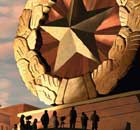Top Biz News
Bears' case has no bite
By Xin Zhiming (China Daily)
Updated: 2010-03-02 11:18
 |
Large Medium Small |
About 10 years ago, a book called The Coming Collapse of China, written by US lawyer Gordon Chang, made a stir as the author claimed that the non-performing loans of major Chinese banks would bring down the nation's financial system and the economy would collapse in 2006.
Now Harvard University Professor Kenneth Rogoff is predicting that China's economic growth will plunge to as low as 2 percent following the collapse of a "debt-fueled bubble" within 10 years, probably around 2020.
Other China bears have sounded similar alarms.
Although Chang pointed out many of the serious problems facing the Chinese economy at the time, his predictions were fatally flawed.
Starting from 1999, China pared off about 1.4 trillion yuan ($205 billion) worth of bad loans from its major banks, which had served as semi-governmental bodies in supporting State enterprises in the past.
Then those banks streamlined their management, got listed on the stock market and saw their non-performing loan ratio drop continually.
China in a sense has repeated its past mistakes by allowing its banks to extend large-scale loans to crisis-stricken enterprises last year as the country spared no effort to defend itself from the fallout of the global economic crisis.
As observers rightly pointed out, last year's lending spree will lead to a rising bad loan ratio in the years to come. This serves as a reminder to Chinese policymakers of the growing risks, but will it lead to such a disastrous outcome as "economic collapse"?
According to the Economist magazine, if we suppose 20 percent of all new lending last year and another 10 percent of this year's lending turns bad, this will result in new bad loans equivalent to 5.5 percent of China's GDP by 2012, compared with 2 percent at the moment.
At this point, it's worth noting that this figure was around 40 percent in the 1990s.
China's effort in solving its bad loan problem has been facilitated by its ever-expanding economy, because as its GDP grows rapidly, the ratio of bad loans to GDP naturally drops, so long as the bad loans don't increase as fast or at even faster rate.
That's an advantage China enjoys in solving its problems.
It remains a relatively poor nation, with far less per capita GDP compared with already affluent Japan in the 1980s.
Many of the China bears have based their argument on a comparison between today's China and Japan in the 1980s.
But this is where the China bears' argument loses its bite.
| ||||
China is yet to complete its urbanization and industrialization, which will combine to unleash huge growth potential for the country.
Will the process be completed as early as 2020?
Probably not.
The author is a senior business correspondent of China Daily













